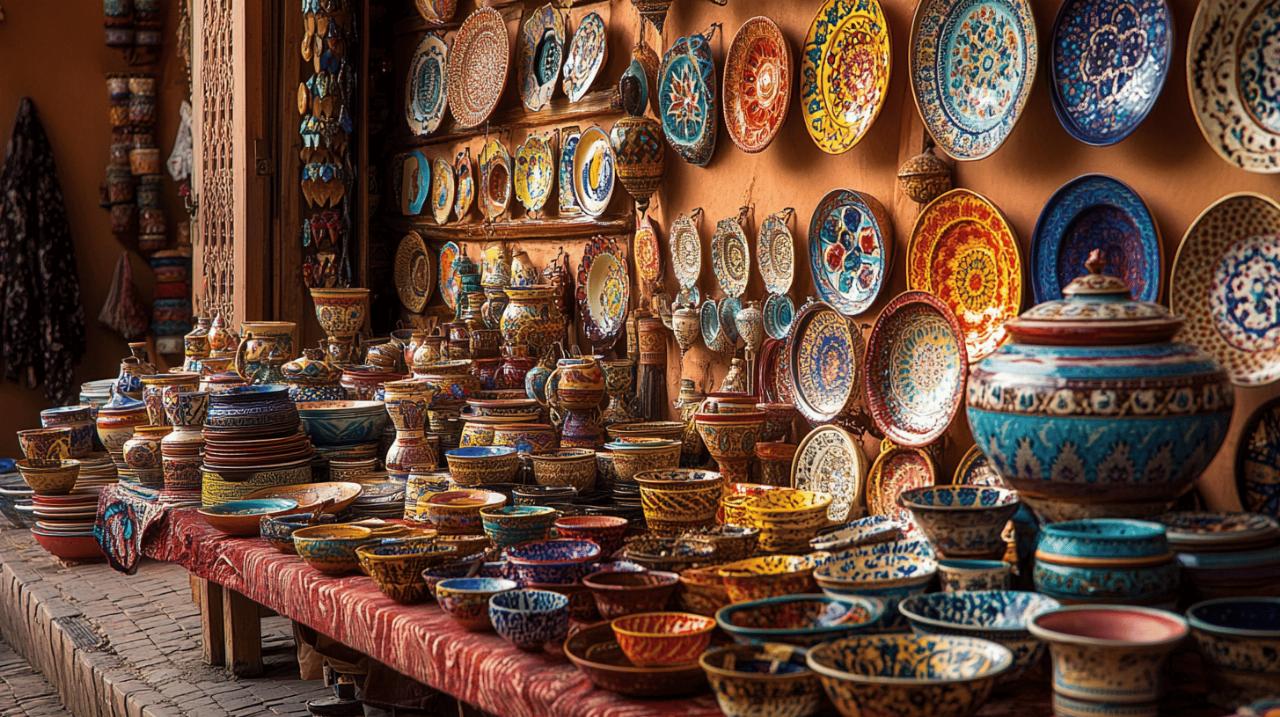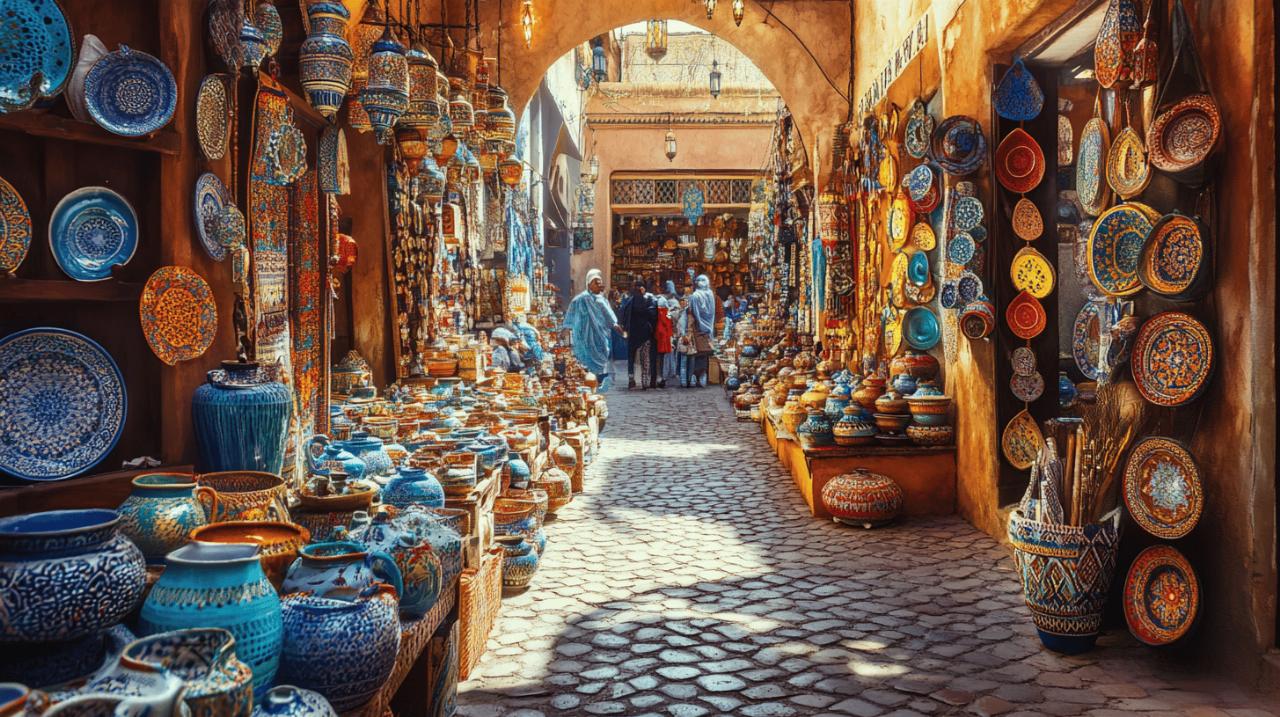Marrakech, the vibrant heart of Morocco, is a treasure trove of sensory delights and shopping opportunities that will leave any visitor spoilt for choice. From bustling souks filled with handcrafted wonders to hidden markets offering unique gems, this enchanting city provides an abundance of memorable souvenirs to bring home. Whether you're after traditional handicrafts or natural beauty products, Marrakech offers an impressive array of authentic keepsakes that capture the essence of Moroccan culture.
Traditional moroccan treasures to take home
Leather babouches and handcrafted goods
No trip to Marrakech would be complete without acquiring a pair of traditional babouche slippers. These comfortable leather footwear pieces serve as both practical souvenirs and delightful reminders of your Moroccan adventure. The Leather Souk is the perfect place to find these iconic slippers, along with an impressive selection of other leather goods including bags, belts, and decorative items. For a truly special find, visit the renowned Ballons d'Or shop, which creates football replicas and has even received recognition from the King of Morocco for its exceptional leatherwork.
Beyond leather, Marrakech excels in diverse handcrafted items that showcase generations of artisanal expertise. The metalwork souks, particularly stalls 44 and 49 in Souk Belaarif, offer stunning brass and copper lanterns that cast magical patterns when lit. These ornate lamps with coloured glass panels make for spectacular decorative pieces that bring Moroccan ambiance into any home. Wooden handicrafts including intricately carved boxes, mirrors, and small furniture pieces demonstrate the remarkable attention to detail that Moroccan craftspeople are famous for.
Textiles and Woven Wonders from the Souks
The textile offerings in Marrakech represent some of the most visually striking souvenirs available. Berber carpets featuring bold geometric patterns and vibrant colours showcase the weaving traditions that have been passed down through generations. These handwoven rugs require significant skill and time to create, making them valuable keepsakes worth the investment. For something smaller yet equally authentic, consider the cactus silk pillows made from agave fibres, which provide a more portable textile souvenir with distinctive Moroccan designs.
Traditional clothing items like embroidered kaftans offer both cultural significance and practical elegance. These flowing garments feature beautiful Moroccan embroidery that tells stories through pattern and colour. Similarly, embroidered linens such as pillowcases and table runners bring a touch of Moroccan artistry to everyday household items. For those interested in the intersection of art and functionality, the hand-painted glassware and ceramic tableware featuring vibrant patterns provide beautiful mementos that can be used and appreciated daily.
Natural moroccan beauty products worth packing
Argan oil: morocco's liquid gold
Morocco is world-renowned for its argan oil, often referred to as 'liquid gold' due to its precious nature and golden hue. This versatile oil is harvested from the nuts of argan trees that grow almost exclusively in southwestern Morocco. The traditional extraction process is labour-intensive, typically performed by local women's cooperatives, which makes authentic argan oil a particularly valuable souvenir. Its popularity stems from its remarkable versatility, as it can be used both in skincare routines and culinary applications.
For beauty enthusiasts, pure argan oil serves as an excellent moisturiser for skin, hair, and nails. Its high vitamin E content and fatty acids make it particularly nourishing for dry or damaged skin. While exploring Marrakech, you'll encounter numerous shops offering argan-based skincare products including creams, serums, and hair treatments. To ensure authenticity, consider purchasing from women's cooperatives or reputable shops rather than tourist-oriented market stalls, as quality can vary significantly. A small bottle of this precious oil makes for a thoughtful gift that embodies Morocco's natural bounty.
Black soap and hammam essentials
The hammam experience is central to Moroccan bathing culture, and you can bring a piece of this tradition home with authentic black soap. This unique product, made from olive oil and enriched with eucalyptus oil, forms the foundation of the traditional hammam ritual. The thick, jelly-like substance works to soften and cleanse the skin while preparing it for exfoliation. Many visitors to Marrakech become instant converts after experiencing its effectiveness firsthand in one of the city's many hammams.
Alongside black soap, consider purchasing a kessa glove, the special exfoliating mitt used during hammam treatments. Together, these items allow you to recreate an authentic Moroccan bathing experience at home. Other hammam essentials worth considering include rose water, which serves as a gentle toner and perfume, and ghassoul clay, a natural mineral clay used as a face and body mask. These natural beauty products represent centuries of Moroccan wellness traditions and make for practical souvenirs that extend the sensory experience of your travels long after returning home.
Hunting for Unique Finds in Marrakech
Exploring the Jewish Quarter for Rare Treasures
 The historic Jewish Quarter, known as the Mellah, offers a shopping experience distinctly different from the main souks of Marrakech. This area provides a more relaxed atmosphere with fewer crowds, allowing visitors to browse at a leisurely pace while discovering unique treasures. The neighbourhood's rich history as a centre for jewellery making means you can find exceptional silver and beaded jewellery pieces that combine Moroccan and Jewish artistic influences. These distinctive designs often feature intricate filigree work and incorporate traditional symbols from both cultures.
The historic Jewish Quarter, known as the Mellah, offers a shopping experience distinctly different from the main souks of Marrakech. This area provides a more relaxed atmosphere with fewer crowds, allowing visitors to browse at a leisurely pace while discovering unique treasures. The neighbourhood's rich history as a centre for jewellery making means you can find exceptional silver and beaded jewellery pieces that combine Moroccan and Jewish artistic influences. These distinctive designs often feature intricate filigree work and incorporate traditional symbols from both cultures.
Beyond jewellery, the Mellah houses speciality shops selling authentic antiques and vintage items that tell stories of Morocco's diverse cultural heritage. Here you might uncover old Berber jewellery, vintage textiles with unique patinas, or decorative objects that have witnessed decades of Moroccan history. For those interested in cultural exploration alongside shopping, the quarter is home to significant historical sites including the Slat Al Azama Synagogue and the Jewish Cemetery. A visit to this neighbourhood provides both meaningful souvenirs and deeper insights into Marrakech's multicultural past.
Khemis market: a trove of distinctive trinkets
For those seeking truly off-the-beaten-path shopping experiences, the Khemis Market offers an authentic glimpse into local commerce away from tourist-oriented venues. This Thursday market (Khemis means Thursday in Arabic) specialises in second-hand goods, creating a treasure hunt atmosphere where patient explorers can uncover genuine finds. Unlike the more curated displays of the main souks, Khemis presents a jumble of possibilities where vintage ceramics might sit alongside traditional musical instruments like ouds and darbukas.
The market's eclectic nature means you might discover anything from antique tea sets to hand-painted calligraphy art. Bargaining is not just expected but essential at Khemis, where initial prices rarely reflect actual value. This market particularly appeals to collectors and those seeking unconventional souvenirs with character and history. While navigating the sprawling stalls requires some perseverance, the potential rewards include one-of-a-kind items that few other visitors will bring home. For photography enthusiasts, the market's vibrant scenes of everyday Moroccan commerce provide memorable visual souvenirs as well.
Fossils and minerals: marrakech's geological marvels
Where to find authentic fossil specimens
Morocco boasts an impressive geological heritage, with the Atlas Mountains and surrounding regions yielding remarkable fossil specimens that date back millions of years. In Marrakech, discerning shoppers can find authentic ammonites and trilobites that serve as tangible connections to the prehistoric past. The best locations for fossil hunting include specialised shops in the Ensemble Artisanal, a government-regulated artisan centre that helps ensure authenticity, and select dealers in the Rahba Kedima square who have established reputations for genuine specimens.
When searching for fossils, it's worth seeking out vendors who can provide information about the specimen's origin and age. Authentic pieces will typically come with details about the geological formation and location where they were discovered. The most common Moroccan fossils include spiral ammonites from the Jurassic period and trilobites dating back to the Cambrian era. These ancient treasures make for distinctive souvenirs that combine natural history with artistic appeal, as many specimens are prepared and mounted to highlight their natural patterns and structures.
Selecting quality minerals and crystals
Beyond fossils, Morocco is renowned for its diverse mineral specimens, with the Atlas Mountains yielding everything from quartz crystals to striking geodes. When shopping for minerals in Marrakech, look for pieces with clear formation, vibrant colour, and minimal damage. Quality specimens will showcase natural crystalline structures rather than appearing artificially enhanced or dyed. Reputable dealers should be willing to discuss the mining location and mineral composition of their offerings.
Popular Moroccan minerals include vanadinite with its distinctive red hexagonal crystals, celestite with delicate blue formations, and dramatic geodes lined with amethyst or clear quartz crystals. For those interested in both aesthetics and metaphysical properties, many shops offer information about the traditional beliefs associated with different stones. When making your selection, consider both display potential and ease of transport, as some larger specimens can be quite heavy. A carefully chosen mineral specimen serves as both a beautiful decorative piece and a natural souvenir that captures the geological diversity of Morocco's ancient landscapes.
